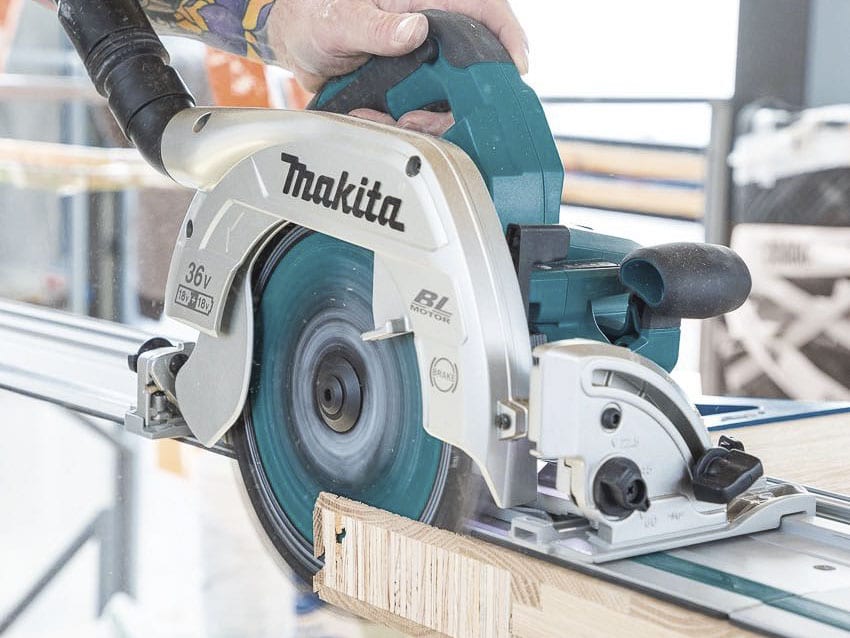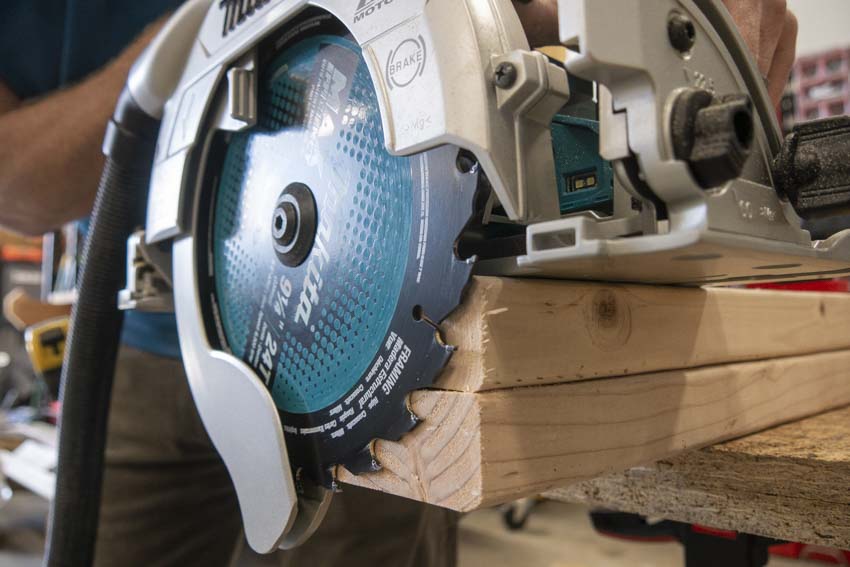Picture this: you’re working on a woodworking project, and all of a sudden, your circular saw starts pulling to one side. Frustrating, right? Well, worry not, my young DIY enthusiast! In this guide, we’ll delve into the reasons why your circular saw might be misbehaving and pulling to one side. By the end, you’ll have a firm grasp on how to tackle this issue and get your saw back on track.
Now, you may be wondering, “Why does my circular saw pull to one side?” It’s a common problem, but the good news is, there are several possible explanations. Factors like a misaligned blade, a worn-out or dull blade, an incorrectly set rip fence, or even poor technique can all contribute to this annoying sideward pull. But fear not, because we’re here to break down each of these causes and provide you with the solutions you need.
So, grab your safety goggles and put on your curious thinking cap, because we’re about to embark on a journey through the world of circular saws. By the end, you’ll be armed with the knowledge to troubleshoot and fix that pesky pulling issue. Let’s dive in, shall we?

Why Does My Circular Saw Pull to One Side?
If you’ve ever used a circular saw, you may have experienced the frustration of it pulling to one side. This can make it difficult to achieve accurate cuts and can even pose a safety risk. But why does this happen? In this article, we will explore the various factors that can cause a circular saw to pull to one side and provide tips on how to address this issue.
Common Causes of a Circular Saw Pulling to One Side
There are several potential reasons why a circular saw may pull to one side. Understanding these factors can help you troubleshoot and resolve the issue. Here are some of the most common causes:
Dull or Uneven Blade
A dull or uneven blade is one of the primary culprits behind a circular saw pulling to one side. When the blade is not sharp or is unevenly worn, it can cause the saw to veer off course during a cut. This is particularly true if you are working with denser or tougher materials. To address this issue, ensure that your blade is sharp and in good condition. Consider replacing it if necessary.
Improper Alignment
Another factor that can cause a circular saw to pull to one side is improper alignment. If the blade is not aligned properly with the saw’s base plate, it can result in an uneven cut and the saw veering off course. To check the alignment, remove the blade guard and inspect the blade’s position in relation to the base plate. Adjust it as necessary to ensure proper alignment.
Poor Technique
Often, the issue of a circular saw pulling to one side can be attributed to poor technique. If you’re applying uneven pressure or angling the saw incorrectly while making a cut, it can cause the saw to deviate from its intended path. To improve your technique, make sure you’re using a firm grip, maintaining a consistent cutting angle, and applying even pressure throughout the cut.
Inadequate Power or Speed
A circular saw that is underpowered or operating at an insufficient speed can also contribute to it pulling to one side. If your saw doesn’t have enough power to cut through the material smoothly or if you’re using a speed that is too low for the specific material, the saw may struggle and veer off course. Ensure that your circular saw is appropriate for the task at hand and that you’re using the correct speed setting.
Material Binding
When working with certain types of materials, such as warped or rough-cut wood, the saw blade can become pinched or caught, leading to the saw pulling to one side. This is known as material binding. To prevent this, ensure that your materials are properly prepared and supported during the cut. Use clamps or other methods to secure the material in place and prevent it from shifting or binding.
Uneven Weight Distribution
The weight distribution of the circular saw itself can also play a role in it pulling to one side. If the weight is not evenly distributed or if there is an imbalance, it can affect the saw’s stability and cause it to veer off course. Check the balance of your saw and make sure that it is properly calibrated and adjusted for optimal performance.
Inadequate or Incorrect Adjustments
Lastly, inadequate or incorrect adjustments to the saw’s settings can contribute to it pulling to one side. This can include the depth of cut, bevel angle, or other adjustments. Ensure that you have set the saw to the appropriate settings for your desired cut and that you have made any necessary adjustments based on the specific material or task at hand.
Tips for Addressing a Circular Saw Pulling to One Side
Now that we’ve identified the common causes of a circular saw pulling to one side, let’s discuss some tips for addressing this issue:
Tip #1: Maintain a Sharp Blade
Regularly inspect and sharpen your circular saw blade to ensure it is in optimal cutting condition. Replace the blade if it is dull or damaged.
Tip #2: Check Alignment
Verify that the blade is aligned correctly with the base plate. Make necessary adjustments to achieve proper alignment.
Tip #3: Improve Technique
Practice proper cutting technique, ensuring even pressure and a consistent cutting angle throughout the cut.
Tip #4: Use Sufficient Power and Speed
Ensure that you are using a circular saw with adequate power for the material you are cutting and that you are operating at an appropriate speed.
Tip #5: Prepare Materials Properly
Take the time to properly prepare your materials, ensuring they are free from warping or other issues that can lead to material binding.
Tip #6: Check Weight Distribution
Verify that the weight of your circular saw is evenly distributed and adjust as needed to achieve a balanced saw.
Tip #7: Make Accurate Adjustments
Double-check and adjust the saw’s settings to ensure they are appropriate for your desired cut and material.
Conclusion
If you’ve been frustrated by your circular saw pulling to one side, understanding the potential causes and implementing the tips provided can help you achieve more accurate and controlled cuts. Remember to always prioritize safety when working with power tools and consult the manufacturer’s instructions for your specific circular saw model. With proper technique, maintenance, and adjustments, you can overcome this common issue and achieve excellent results with your circular saw.
Key Takeaways: Why does my circular saw pull to one side?
- Uneven blade alignment can cause a circular saw to pull to one side.
- Using a dull blade can also lead to the saw pulling to one side.
- Improper technique, such as leaning or applying uneven pressure, can cause pulling to occur.
- Certain factors, such as the type of material being cut, can contribute to the saw pulling to one side.
- Regular maintenance and ensuring proper blade tension can help prevent pulling issues.
Frequently Asked Questions
Introduction: Have you ever experienced your circular saw pulling to one side while cutting? Don’t worry, it’s a common issue. In this section, we’ll answer some frequently asked questions about why your circular saw may be pulling to one side.
Question 1: How do I prevent my circular saw from pulling to one side?
Answer: There are a few steps you can take to prevent your circular saw from pulling to one side. First, ensure that the blade is properly aligned and tightened. A loose or misaligned blade can cause the saw to pull to one side. You should also check that the blade is sharp; a dull blade can cause the saw to deviate from its path. Additionally, make sure that you are applying steady and even pressure when cutting. Inconsistent pressure can lead to the saw veering off course.
Question 2: Why does my circular saw pull to the right when cutting?
Answer: If your circular saw consistently pulls to the right while cutting, it may be due to a few reasons. One possibility is that the blade is dull on the right side, causing it to cut less effectively and pushing the saw off track. Try sharpening or replacing the blade to see if that solves the issue. Another potential cause is an uneven surface or material. If the material you are cutting is not level, the saw may veer to the right. Ensure that your work surface is even and use clamps or guides to hold the material in place if necessary.
Question 3: What can cause my circular saw to pull to the left instead?
Answer: If your circular saw is consistently pulling to the left when cutting, there are a few factors that could be contributing to the issue. One common cause is an improperly aligned or tightened blade. Make sure the blade is straight and securely fastened to avoid any deviations. Another possibility is that the motor or gearbox of the saw is not functioning properly, resulting in uneven power distribution and causing the saw to veer to the left. In this case, it may be necessary to have your saw inspected or repaired by a professional.
Question 4: Can the type of blade affect the way my circular saw pulls?
Answer: Yes, the type of blade you use can have an impact on how your circular saw pulls. Different types of blades are designed for specific materials and cutting tasks. Using the wrong blade for a particular application can cause the saw to pull to one side. For example, if you are cutting hardwood but using a blade designed for softer materials like plywood, the saw may have difficulty cutting smoothly and result in pulling. Make sure you choose the right blade for the material you are working with to ensure optimal performance.
Question 5: What are some additional tips for keeping my circular saw on track?
Answer: Here are some additional tips to help keep your circular saw on track while cutting. Firstly, always use a guide or a straight edge to ensure a straight cutting line. This will provide a stable reference point and help prevent the saw from pulling to one side. Secondly, maintain a consistent cutting speed throughout your cut. Rapid changes in cutting speed can cause the saw to veer off course. Finally, practice proper technique and ensure a firm grip on the saw to maintain control and minimize any pull or deviation.

HOW TO TUNE A CIRCULAR SAW
Summary
So, if your circular saw keeps pulling to one side, here’s what you need to know. First, check the blade, making sure it’s sharp and properly aligned. Next, check the base plate and ensure it’s flat and not bent. Also, make sure you’re applying equal pressure on both sides of the saw while cutting. Additionally, if you’re using a corded saw, check the power source and ensure it’s providing a steady flow of electricity. Finally, practice precise cutting techniques to improve your control over the saw.
Remember, a sharp and properly aligned blade, a flat base plate, equal pressure, a steady power source, and good cutting techniques can help eliminate the issue of your circular saw pulling to one side. Happy and safe cutting!
